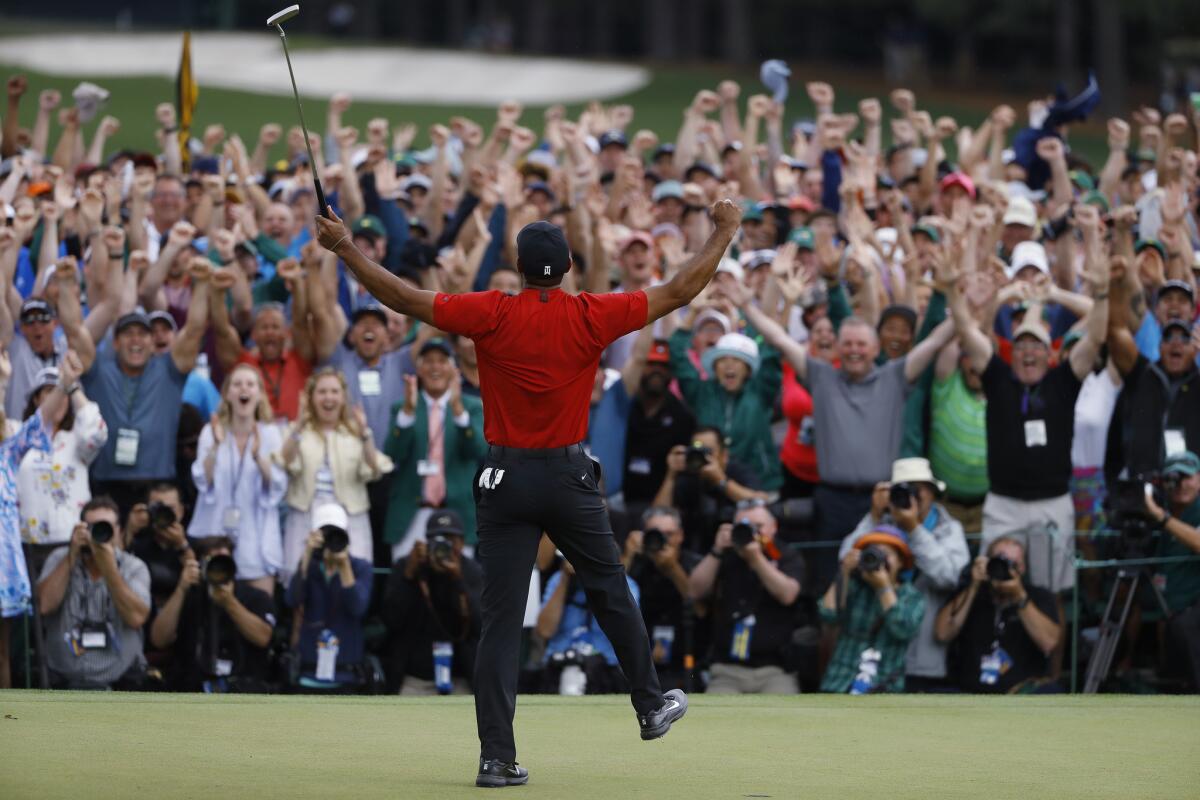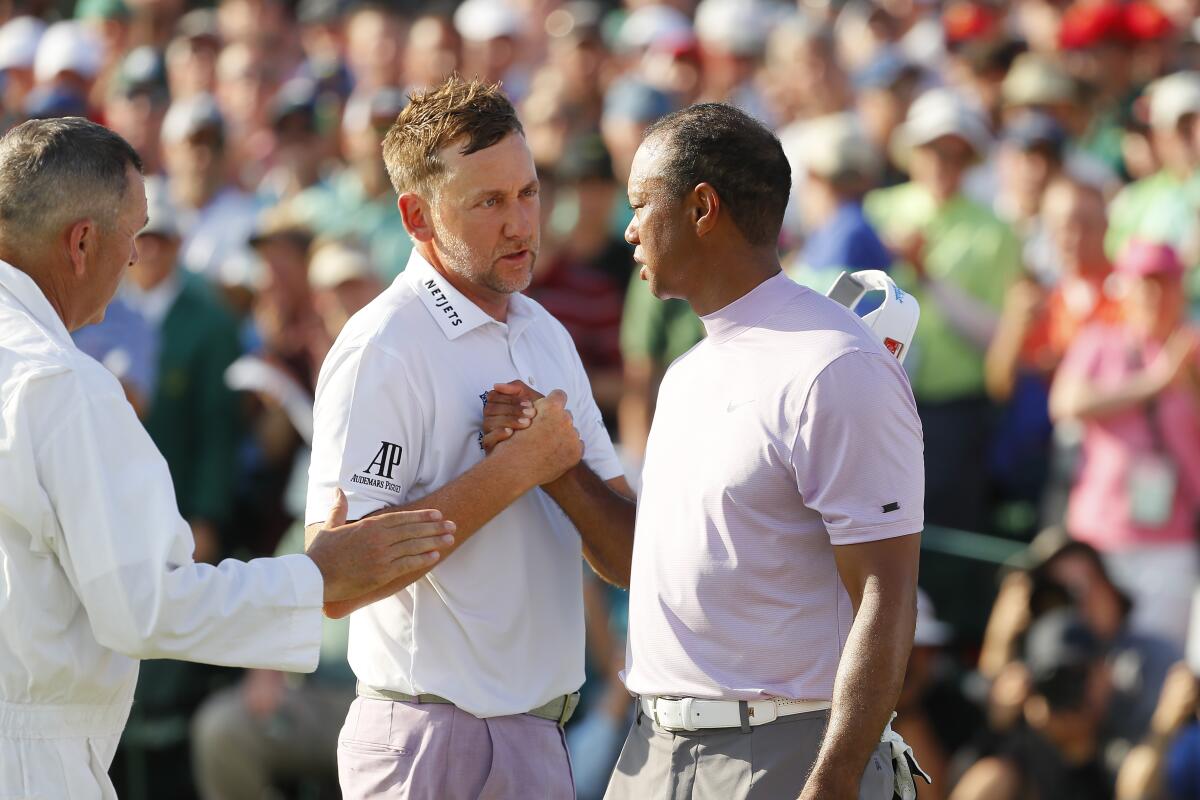Book excerpt: Sunday is when Tiger Woods made golf history, but Saturday is when he won the 2019 Masters

- Share via
More than a decade had passed since Tiger Woods won his last major golf tournament when he arrived at Augusta National Golf Club last April for the 2019 Masters. However, strong finishes at two majors in 2018 and a victory at the Tour Championship had created a palpable anticipation that some old Woods magic was in the air.
Golfers try to hide their competitiveness, or that was the old tradition. Tiger didn’t and couldn’t. On any Saturday, at any tournament, Tiger wants to beat the guy he’s playing with. If he’s playing well and winning is within grasp and reason, beating his Saturday playing partner becomes even more important. And if his Saturday partner is somebody he doesn’t like, that suits Tiger just fine. Golf at Tiger’s level requires mechanics, but it requires emotion, too. All competitive golf does.
You almost had to feel sorry for Ian Poulter, paired with Tiger for Saturday and starting the round one shot behind him. Tiger was playing well, and he finds Poulter, as some do, annoying. (Too cheeky, too loud.) Then Poulter had the audacity to show up at Augusta on Saturday wearing lilac pants. Had he not read the pre-tournament memo from Nike that Tiger had already claimed lilac for Saturday, as his color for his third-round mock turtleneck? That meant he owned lilac for the day. Poor Poulter. Tiger likes to beat everybody, but some golfers he likes beating more than others.
The first two days at the Masters are different from its Saturdays, and the Saturdays are different from the Sundays. On Thursday and Friday, the players go off in threesomes. On the weekends, after the thirty-six-hole cut, they play in twosomes. Table setting is done. Play is faster. By Sunday, when there might be twenty players left with a chance to win, the mood is tight and tense.
Having completed one of the most improbable comebacks in sports, an unfathomable revival, Tiger Woods walked off the 18th green at Augusta National on Sunday and wrapped his children in his arms — first his 10-year-old son, Charlie, then his 11-year-old daughter, Sam.
By Saturday, Tiger knows the course, as it’s playing that year, much better. He has adjusted to the speed of the greens and the length of the fairway grass. He knows where his game is and what he can and cannot do. He knows that the better he plays on Saturday, the more judicious he can be on Sunday, and he’s a judicious golfer, much more so than it might appear. He starts his Saturday with a number in mind, what he wants to shoot. He’s hinted at that many times over the years. What he doesn’t acknowledge is a secondary goal, which is to bury his Saturday playing partner. That we can see for ourselves. The greater the beating, the better. One less guy to worry about on Sunday. Tiger invented that mentality. Hogan never had it, and neither did Arnold, Jack, Watson, or Norman. To win a tournament by one or two is fine, Tiger once told Charlie Rose, “but it’s a lot better if you win it by five or six.”

Saturday’s all right for fighting. In one corner, in the lilac T-shirt, the former heavyweight champion of the world. In the other, in lilac trousers, Kid Poults, all the way from England. The first tee at Augusta National — the tee box, in the game’s descriptive jargon — 1`is a dead-flat perfect rectangle of green. It was open on one end and lined three deep by spectators on the other three sides. There was a dampness in the rising warmth, the smell of spring earth with it, everybody hatted and lotioned. Fore, please. A hushed quiet. Tiger Woods, now driving. A round of applause, a moment of silence. The violent click of a graphite driver head smashing into a plastic golf ball at 120 miles per hour. Tiger looked pleased enough. The sounds of a switchblade and a motorbike.
::
The 2019 Masters was the seventy-fifth major that Tiger had played in as a pro. In the first forty-six of them, Tiger had won fourteen. In the third round of each of those wins, with one exception, Tiger shot a lower score than his playing partner. That’s some burial program. Along those same lines, as an amateur, Tiger won thirty-six consecutive USGA matches over six years. That’s why Nike gave him that giant payday when he turned pro. As a pro, Tiger won eleven of his first twelve playoffs, which told you that his match-play knockout mentality was alive and well. All those Saturday rounds told you the same thing. He was going to beat the guy in front of him.
In the third round of each of his previous 14 majors wins, with one exception, Tiger shot a lower score than his playing partner. That’s some burial program.
At the 1997 Masters, Tiger was paired with Colin Montgomerie on Saturday. Tiger shot a 65 to Monty’s 74. Before that round, his father, Earl, told Tiger, “Go out there and kick some butt.” After that round, Monty told reporters in his authoritative Scots-English accent, “We’re all human beings here. There’s no chance humanly possible that Tiger is just going to lose this tournament.” That was the year Tiger won by twelve.
In 2001 Tiger shot a Saturday 68 to Chris DiMarco’s 72. That meant on Sunday, DiMarco would be playing with Mark Calcavecchia, and DiMarco, after what he had just been through, was relieved. “He’s a Gator, I’m a Gator,” he said that Saturday night, referring to the mascot of their alma mater. “Go out and have fun.” A common Tour attitude, but foreign to Tiger.
In 2002 Tiger shot a third-round 66 to José María Olazábal’s 71. “It was the easiest sixty-six at Augusta I have seen in all my life,” Olazábal said years later. “He dissected the course. I remember the Spanish media started asking me after the round whether I felt I had options for Sunday. I said, ‘What options? Haven’t you seen this guy play? This tournament has an owner.’”
In 2005 Tiger shot 65 to David Howell’s 76. Howell, an Englishman, said afterward, “Tiger is lovely to play with.” It was a genuine compliment. It meant that Tiger went about his business, expertly and courteously, and that he gave Howell the room he needed to play his round, even if it meant shooting 76.
On one level, winning a seventy-two-hole stroke-play golf tournament is simple: Just shoot the lowest score. That’s the genteel way to look at it.
Then there’s the Tiger approach: Beat everybody. And if you want your U.S. Open win in June to help you at the British Open in July, pulverize them. That’s boxing, and that’s match-play golf, once you make an allowance for all those good putt shout-outs. Stroke-play is the right side of a golfer’s brain. It’s logic and proportion. Match-play comes out of the left, from the capital of controlled emotion. It’s Marvin Gaye singing “Sexual Healing.”
Tiger is wired for match-play. He showed his mastery of stroke- play golf, the pro game, when he won that first Masters in 1997 by twelve. Later, sometime in his mid-twenties, with Y2K in the air and his college buddies in grad school, it must have dawned on Tiger: He had both the match-play gene and the stroke-play gene; he was a left-brain golfer and a right-brain golfer; he could simultaneously seize the day and pace himself. In other words, he was like no golfer before him. He had it all.
On that Saturday at Augusta, Ian Poulter, his visor and shirt dotted with endorsement deals, played a nearly flawless round of golf, a sun-drenched 68. He stood right up to the man and played as well as he could. It wasn’t enough. Tiger shot 67. Tiger’s lead over Poulter had been one. Now it was two. Sunday was coming, and Ian Poulter would be the least of Tiger’s worries.
This article has been adapted from “The Second Life of Tiger Woods” by Michael Bamberger. Copyright © 2020. Available from Avid Reader Press, an imprint of Simon & Schuster. You can purchase the book here
More to Read
Go beyond the scoreboard
Get the latest on L.A.'s teams in the daily Sports Report newsletter.
You may occasionally receive promotional content from the Los Angeles Times.










